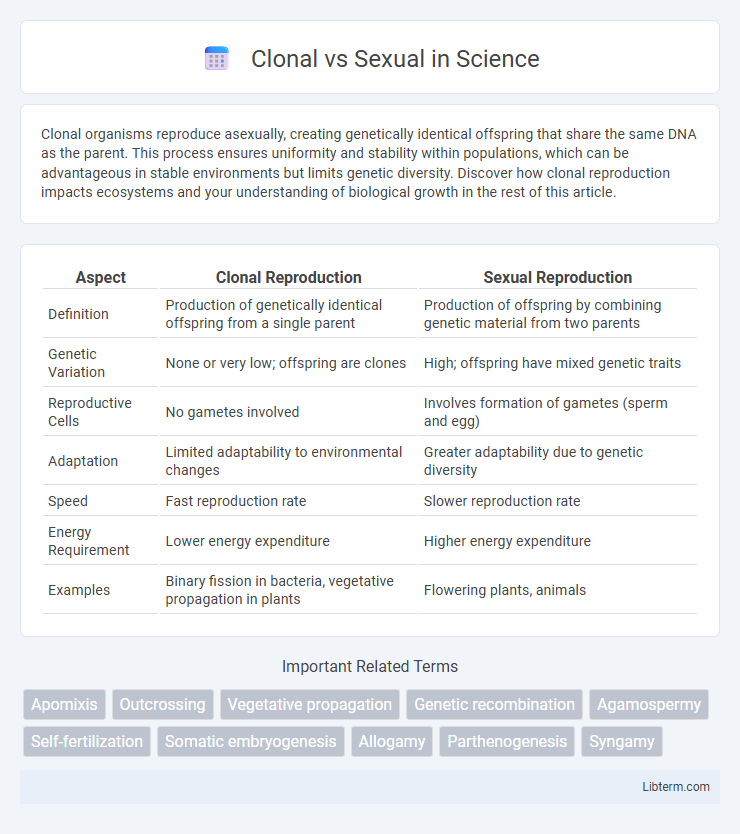Clonal organisms reproduce asexually, creating genetically identical offspring that share the same DNA as the parent. This process ensures uniformity and stability within populations, which can be advantageous in stable environments but limits genetic diversity. Discover how clonal reproduction impacts ecosystems and your understanding of biological growth in the rest of this article.
Table of Comparison
| Aspect | Clonal Reproduction | Sexual Reproduction |
|---|---|---|
| Definition | Production of genetically identical offspring from a single parent | Production of offspring by combining genetic material from two parents |
| Genetic Variation | None or very low; offspring are clones | High; offspring have mixed genetic traits |
| Reproductive Cells | No gametes involved | Involves formation of gametes (sperm and egg) |
| Adaptation | Limited adaptability to environmental changes | Greater adaptability due to genetic diversity |
| Speed | Fast reproduction rate | Slower reproduction rate |
| Energy Requirement | Lower energy expenditure | Higher energy expenditure |
| Examples | Binary fission in bacteria, vegetative propagation in plants | Flowering plants, animals |
Introduction to Clonal and Sexual Reproduction
Clonal reproduction involves offspring genetically identical to a single parent, using methods like binary fission, budding, or vegetative propagation, ensuring rapid population growth without genetic variation. Sexual reproduction combines genetic material from two parents through gamete fusion, resulting in genetically diverse offspring that enhance adaptability and survival in changing environments. Understanding these reproductive strategies is crucial for studying evolutionary biology, agriculture, and biodiversity management.
Definition and Mechanisms of Clonal Reproduction
Clonal reproduction is an asexual reproductive mechanism where offspring are genetically identical to a single parent, produced through processes such as budding, fragmentation, or vegetative propagation. This mode bypasses genetic recombination by replicating the parent's DNA directly, resulting in uniform populations with minimal genetic variation. In contrast, sexual reproduction involves the fusion of gametes from two parents, generating genetic diversity through meiosis and fertilization.
Definition and Mechanisms of Sexual Reproduction
Clonal reproduction produces genetically identical offspring through mechanisms like binary fission, budding, or vegetative propagation, maintaining the parent's genetic makeup. Sexual reproduction involves the fusion of haploid gametes from two parents, resulting in genetically diverse offspring due to processes like meiosis, crossing over, and fertilization. This genetic variation enhances adaptability and evolution in populations by mixing alleles and creating novel gene combinations.
Genetic Diversity: Clonal vs. Sexual Strategies
Clonal reproduction produces genetically identical offspring, limiting genetic diversity and adaptability in changing environments. Sexual reproduction generates offspring with genetic variation through recombination and independent assortment, enhancing population resilience. Genetic diversity from sexual strategies supports evolutionary potential and reduces vulnerability to diseases compared to clonal populations.
Evolutionary Advantages of Clonal Reproduction
Clonal reproduction offers evolutionary advantages by enabling rapid population expansion without the need for a mate, ensuring genetic consistency and allowing organisms to exploit stable environments efficiently. This mode of reproduction preserves advantageous gene combinations, reducing the genetic load of deleterious mutations through mechanisms like gene conversion. Clonal species often dominate in habitats where environmental conditions remain constant, facilitating successful colonization and resource utilization.
Evolutionary Advantages of Sexual Reproduction
Sexual reproduction promotes genetic diversity by combining different alleles from two parents, enhancing a population's ability to adapt to changing environments and resist diseases. This genetic variation drives natural selection, accelerating evolutionary processes and increasing long-term survival chances. Clonal reproduction produces genetically identical offspring, limiting adaptability but allowing rapid population growth under stable conditions.
Ecological Impacts and Adaptability
Clonal reproduction allows rapid colonization and persistence in stable or harsh environments by producing genetically identical offspring, enhancing local population resilience but limiting genetic diversity. Sexual reproduction generates genetic variation, improving adaptability and long-term survival under changing ecological conditions and environmental stressors. The balance between clonal and sexual strategies influences ecosystem dynamics, species interactions, and evolutionary potential in response to habitat disturbances.
Case Studies: Examples from Nature
Clonal reproduction in aspen trees demonstrates rapid colonization and genetic uniformity, facilitating resilience in stable environments. In contrast, sexual reproduction in coral species like Acropora enhances genetic diversity, improving adaptability to changing ocean conditions. Studies on dandelions reveal clonal propagation dominates in disturbed habitats, while sexual reproduction prevails in more stable ecosystems, highlighting evolutionary trade-offs.
Challenges and Limitations of Each Method
Clonal reproduction faces challenges such as limited genetic diversity, making populations more susceptible to diseases and environmental changes. Sexual reproduction, while promoting genetic variation, encounters limitations like slower population growth and greater energy investment in mating processes. Both methods impact species adaptability, with clonal reproduction risking reduced resilience and sexual reproduction facing constraints in survival rates of offspring.
Clonal vs. Sexual Reproduction: Future Perspectives
Emerging research in clonal versus sexual reproduction highlights the potential of clonal methods to rapidly propagate genetically identical organisms, ensuring trait stability and uniformity in agriculture and conservation. Advances in CRISPR and gene editing enhance the precision and efficiency of clonal propagation, reducing generation cycles compared to sexual reproduction. Future perspectives emphasize integrating clonal reproduction with genomic technologies to optimize yield, disease resistance, and adaptability in changing environments.
Clonal Infographic

 libterm.com
libterm.com